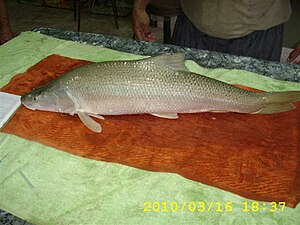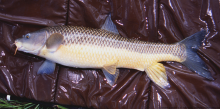Luciobarbus
| Luciobarbus | ||||||||||||
|---|---|---|---|---|---|---|---|---|---|---|---|---|

Luciobarbus esocinus , the type species of the genus |
||||||||||||
| Systematics | ||||||||||||
|
||||||||||||
| Scientific name | ||||||||||||
| Luciobarbus | ||||||||||||
| Heckel , 1843 |
Luciobarbus ( Syn .: Messinobarbus Bianco, 1998 ) is a genus of carp fish (Cyprinidae). The genus occurs in North Africa ( Tunisia , Algeria and Morocco ), on the Iberian Peninsula , in Asia Minor , in the Caucasus and its northern foothills, in Mesopotamia , in western Iran and in the catchment area of the Caspian Sea and the Aral Sea . It wasset upby Johann Jakob Heckel as early as 1843, but for a long time it was not recognized and its species were assigned to the genus Barbus .
features
Luciobarbus species are 23 cm to 2.30 meters long. They differ from the Barbus species, among other things, in the shape of the lower lip, the middle section of which in Luciobarbus has no papillae, while in Barbus it is completely covered with papillae. In addition, the number of teeth in the main row of the pharyngealia is different: four in Luciobarbus , five in Barbus .
Other features of the genus include the high mean outgrowth and the broad base plate of the Urohyale, a tendon ossification in the skull, the broad fourth and fifth infraorbitalia (bones around the eyes), the front edge of the cleithrum that is perpendicular to the lower thigh and its long and narrow upper leg. In addition, the convex anterior edge of the gill cover, the broad ethmoid , the small vor vomer , which has a long and sharp point, and the tendency that in old fish the number of gullet teeth decreases and the fourth in the outer row becomes particularly strong. You also get crescent-shaped chewing surfaces. The basal plate of the pharyngealia is elongated downwards.
evolution
The genera Barbus and Luciobarbus separated in the late Miocene about 8 million years ago. The split followed the successive plate tectonic movements that took place in the southern Mediterranean region. In the Pliocene, about 2 million years ago, the establishment of today's river systems resulted in rapid speciation in both genera.
species
The genus currently contains almost 40 species:
- Luciobarbus bocagei (Steindachner, 1864)
- Aral barbel ( Luciobarbus brachycephalus ) (Kessler, 1872)
- Luciobarbus callensis (Valenciennes, 1842)
- Bulatmai barbel ( Luciobarbus capito ) (Güldenstädt, 1773)
- Luciobarbus caspius (Berg, 1914)
- Luciobarbus chelifensis Brahimi, Freyhof, Henrard & Libois, 2017
- Iberian barbel ( Luciobarbus comizo ) (Steindachner, 1864)
- Luciobarbus escherichii (Steindachner, 1897)
- Luciobarbus esocinus Heckel, 1843 ( type species )
- Luciobarbus graecus Steindachner, 1896
- Luciobarbus graellsii (Steindachner, 1866)
- Luciobarbus guercifensis Doadrio, Perea & Yahyaoui, 2016
- Luciobarbus guiraonis (Steindachner, 1866)
- Luciobarbus kersin (Heckel, 1843)
- Luciobarbus kosswigi (Karaman, 1971)
- Luciobarbus kottelati Turan, Ekmekçi, İlhan & Engin, 2008
- Luciobarbus lanigarensis Brahimi et al., 2018
- Luciobarbus leptopogon (Schimper, 1834)
- Luciobarbus lydianus (Boulenger, 1896)
- Luciobarbus maghrebensis Doadrio, Perea & Yahyaoui, 2015
- Luciobarbus mascarensis Brahimi, Freyhof, Henrard & Libois, 2017
- Luciobarbus microcephalus (Almaça, 1967)
- Luciobarbus mursa (Güldenstädt, 1773)
- Luciobarbus mystaceus (Pallas, 1814)
- Luciobarbus nasus (Günther, 1874)
- Luciobarbus numidiensis Brahimi et al., 2018
- Luciobarbus pectoralis (Heckel, 1843)
- Luciobarbus rabatensis Doadrio, Perea & Yahyaoui, 2015
- Luciobarbus rifensis Doadrio, Perea & Yahyaoui, 2015
- Luciobarbus sclateri (Günther, 1868)
- Luciobarbus steindachneri (Almaça, 1967)
- Luciobarbus subquincunciatus (Günther, 1868)
- Luciobarbus xanthopterus Heckel, 1843
- Luciobarbus yahyaouii Doadrio et al., 2016
- Luciobarbus zayanensis Doadrio, Perea & Yahyaoui, 2016
literature
- Ignacio Doadrio: Phylogenetic relationships and classification of western palaearctic species of the genus Barbus (Osteichthyes, Cyprinidae). Aquat. Living Resour., 3, 1990, pp. 265-282 ( PDF file ).
- Davut Turan, Fitnat Güler Ekmekçi, Ali İlhan & Semih Engin: Luciobarbus kottelati, a new species of barbel (Teleostei: Cyprinidae) from the Büyük Menderes River, Turkey, with rediagnose of L. lydianus. Zootaxa 1824, 2008, pp. 35–44 ( abstract; PDF file; 19 kB ).
- Rafael Zardoya, Ignacio Doadrio: Molecular Evidence on the Evolutionary and Biogeographical Patterns of European Cyprinids. J Mol Evol, 49, 1999, pp. 227-237 ( PDF file ).
Individual evidence
- ↑ Luciobarbus esocinus on Fishbase.org (English)
- ↑ a b c Casal-Lopez, M., Perea, S., Yahyaoui, A. & Doadrio, I. (2015): Taxonomic review of the genus Luciobarbus Heckel, 1843 (Actinopterygii, Cyprinidae) from Northwestern Morocco with the description of three new species. Graellsia, 71 (2): e027.
Web links
- Luciobarbus on Fishbase.org (English)




